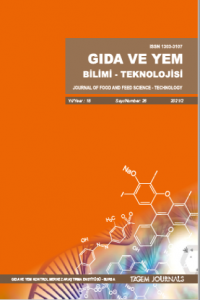HAZIR YEMEKLERİN Staphylococcus aureus VE ENTEROTOKSİN İÇERİĞİ AÇISINDAN RİSK DEGERLENDİRMESİ
Staphylococcus aureus, Koliform, Gıda zehirlenmeleri, Enterotoksin, Mikrobiyoloji, Hazır yemek
___
- Anonymous, 2005.Merck Gıda Mikrobiyolojisi Uygulamaları. Ed: A.K. Halkman. Başak Matbaacılık Ltd. Şti., Ankara, 181-187
- Aydın, A., Sudagidan, M., Muratoğlu, K., 2011. Prevalence of Staphylococcal enterotoxins genes and genetic- relatedness of foodborme Sraphylococcus aureus strains isolated in marmara Region of Turkey: Int. Joumal of Food Micr. Volume 148, Issue 2: 99-106
- Association of Official Analytical Chemists (AOAC) International 070404/2007:06
- Ayçiçek, H., Cakıroğlu, ve S., Stevens, H.T., 2003. Incidense of Staphylococcus aureus in ready-to-cat meals from military cafetarias in Ankara, Turkey
- Bilge, F., Karaboz, İ., 2005. İzmir'de piyasada açıkta satışa sunulan bazı gıdaların Staphylococcus aureus ve enterotoksinleri bakımından incelenmesi
- Central Desease Control, 2011. E7D Journal, Vol: 17, Number 9 40
- Çolak, H., Hampikyan, H., Ulusoy, B., Bingöl, B. ve Akha, M., 2008.İstanbul'da tüketime sunulan bazı ızgara tipi gıdalar ile salata ve mezelerin mikrobiyolojik kalitelerinin belirlenmesi: Türk Mikrobiyoloji Cem Derg 38 (2): 87-94
- Güven, K., Mutlu, B.M., Gülbandılar, A., Çakır, P., 2010. Occurance characterization of Staphylococcus aureus isolated from meat and dairy products consumed in Turkey: Journal of Food safety, Volume: 30: 197-212
- Feng, P., Weagant, S.D., Grant, M.A., Burkhardt, W.2013.Enumaration of E. coli and Coliform bacteria. Bacteriological anltical Manuel, Food and Drug Administration, http://fda/food/food science research/ LaboratoryMethods/ucm2006949 htm
- Jay, JM., 1992. Sfaphylococcal gasteroenteritis, In: Modem Food Microbiology. 4th Edition, New York: Avi Book,; 455-471
- Kim, N.H., Yun, A.R., Rhee, M.S, 2011. Prevalence and classification oftoxigenic Staphylococcus aures isolated from refrigerated ready to cat foods (sushi, kimbab, Califomia rolls) in Korea, Journal of Applied Microbiology, ISSN 1364-5072 pp.1456-1464
- Kotzeikov, P., 2013. Microbiological examinations of ready to cat foods and ready to bake frozen pastries from university canteens: Food Microbiology, Vol:34, İssue 2:337-343
- National Standart Method-2005- Direct Enumaration of £. coli-F20
- Omoe, K, Imanishi, K., Hu, D.L. and Kato, H. (2004).Biological properties of Staphylococcal enterotoxin-like toxin type R. Infection and Immunity; 72(6): 3664-3667
- Pereira, V., Lopes, C., Castro, A., Silva, J., Gibns, P., Terxwira, P., 2009. Characterization for enterotoksin production virulence factors and antibiotic susceptibility of Staphylococcus aureus isolates from various foods in Potugal. Food Microbiology, 26: 278-282.
- Rosec, JP, Guiraud, JP, Dalet, J. and Richard, N. 1997. Enterotoxin production by Staphylococci isolated from foods in France. Food Microbiol; 35: 213-221
- Stevens, D.L., Ma, Y., Salmi, D.B., Mcindoo, E., Wallace, R.J. and Bryant, A.E., 2007. Impact of antibiotics on expression of virulence- associated exotoxin genes in methicillin-sesitive and methicillin-resistant Staphylococcus aureus. J Infec Dis; 195(15):202-211
- Tatini,, S.R., 1973.Influence of food environments on growth of Staphylococcus aureus and production of various enterotoxins. J. Milk Food Technol.; 36: 559-563
- Tibana, A., Rayman, K., Akthar, M.and Szabo,R., 1987. Thermal stability of enterotoxins A, B, and Cina buffered system. J Food Prot, 50, 239-242
- Tokuç, B.2009.Gıda güvenliği ve Gıda Kaynaklı Hastalıklar, http://www.phd.org.tr/ 14 kongresunum
- Tunail, N., 2000. Gıda mikrobiyolojisi ve uygulamaları, 2, Baskı. Ankara Ünv. Ziraat Fakültesi Gıda müh. yayını, 81-88, Ankara
- Tükel, Ç., Doğan, H., 2000. Gıda Mikrobiyolojisi ve Uygulamaları, 2000. Ankara Ünv. Ziraat Fak. Gıda Müh. Böl. yayını, s: 25
- Ünlütürk, A., Turantaş, F., 2003. Gıda Mikrobiyolojisi, 141-145
- Wieneke, A.A., 1974. Enterotoxin production by strains of Staphylococcus aureus isolated from foods and human beings. J. Hyg. Camb.; 73:255-261
- Vidas Staph Enterotoxin II (SET2) Test Kitapçığı, Ref: 30705, 2008
- Zhang, S., Jandola, J.J. and Stewart, G.C., 1998. The enterotoxin D plasmid of Staphylococcus aureus ancodes a second enterotoxin determinant (sej).FEMS Microbiol.Lett.pp.168, 227-233
- ISSN: 1303-3107
- Yayın Aralığı: Yılda 2 Sayı
- Başlangıç: 2015
- Yayıncı: Bursa Gıda ve Yem Kontrol Merkez Araştırma Enstitüsü
Gülgün F. Ünal ŞENGÖR, Zafer CEYLAN, Hande DOĞRUYOL, Onur GÖNÜLAL
HAZIR YEMEKLERİN Staphylococcus aureus VE ENTEROTOKSİN İÇERİĞİ AÇISINDAN RİSK DEGERLENDİRMESİ
Yasin ÖZDEMİR, Seda KAYAHAN, Özge KESKİNEL
Emel ÜNAL TURHAN, Zerrin ERGİNKAYA, Adnan BOZDOĞAN, Zerrin ASLAN
SÜT BAZLI İÇECEKLER VE DİĞER İÇECEKLERDE PROBİYOTİK CANLILIĞI ÜZERİNE GIDA MATRİKSİNİN ETKİSİ
